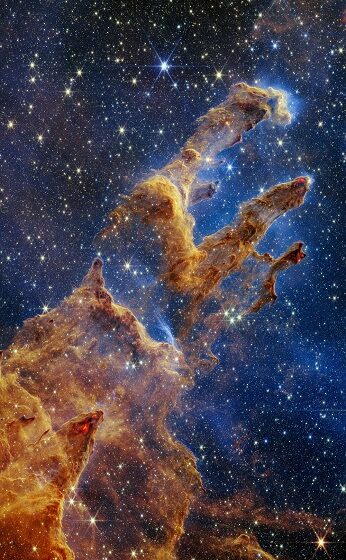Εντυπωσιακό πορτρέτο των εμβληματικών Στηλών της Δημιουργίας από το διαστημικό τηλεσκόπιο James Webb

The Pillars of Creation are set off in a kaleidoscope of colour in the NASA/ESA/CSA James Webb Space Telescope’s near-infrared-light view. The pillars look like arches and spires rising out of a desert landscape, but are filled with semi-transparent gas and dust, and ever changing. This is a region where young stars are forming – or have barely burst from their dusty cocoons as they continue to form. Protostars are the scene-stealers in this Near-Infrared Camera (NIRCam) image. These are the bright red orbs that sometimes appear with eight diffraction spikes. When knots with sufficient mass form within the pillars, they begin to collapse under their own gravity, slowly heat up, and eventually begin shining brightly. Along the edges of the pillars are wavy lines that look like lava. These are ejections from stars that are still forming. Young stars periodically shoot out jets that can interact within clouds of material, like these thick pillars of gas and dust. This sometimes also results in bow shocks, which can form wavy patterns like a boat does as it moves through water. These young stars are estimated to be only a few hundred thousand years old, and will continue to form for millions of years. Although it may appear that near-infrared light has allowed Webb to “pierce through” the background to reveal great cosmic distances beyond the pillars, the interstellar medium stands in the way, like a drawn curtain. This is also the reason why there are no distant galaxies in this view. This translucent layer of gas blocks our view of the deeper universe. Plus, dust is lit up by the collective light from the packed “party” of stars that have burst free from the pillars. It’s like standing in a well-lit room looking out a window – the interior light reflects on the pane, obscuring the scene outside and, in turn, illuminating the activity at the party inside. Webb’s new view of the Pillars of Creation will help researchers revamp models of star formation.
Το διαστημικό τηλεσκόπιο James Webb φωτογράφησε ξανά τις λεγόμενες Στήλες (ή Πυλώνες) της Δημιουργίας, μια εικόνα που είχε τραβήξει το διαστημικό τηλεσκόπιο Hubble αρχικά το 1995 και στη συνέχεια το 2015 και η οποία παραμένει μέχρι σήμερα μια από τις πιο εμβληματικές “σκηνές” του σύμπαντος.
Οι τρεις “στήλες” αποτελούνται από πυκνά νέφη ψυχρών διαστρικών αερίων και σκόνης όπου νέα άστρα σχηματίζονται. Η νέα εικόνα του Webb από την εγγύς-υπέρυθρη κάμερα του εστιάζει στο τεράστιο Νεφέλωμα του Αετού σε απόσταση 6.500 ετών φωτός από τη Γη.
Το Webb είναι το μεγαλύτερο και ισχυρότερο τηλεσκόπιο που έχει ποτέ εκτοξευτεί στο διάστημα, αποτελώντας συνεργασία της Αμερικανικής (NASA), της Ευρωπαϊκής (ESA) και της Καναδικής Διαστημικής Υπηρεσίας (CSA).









